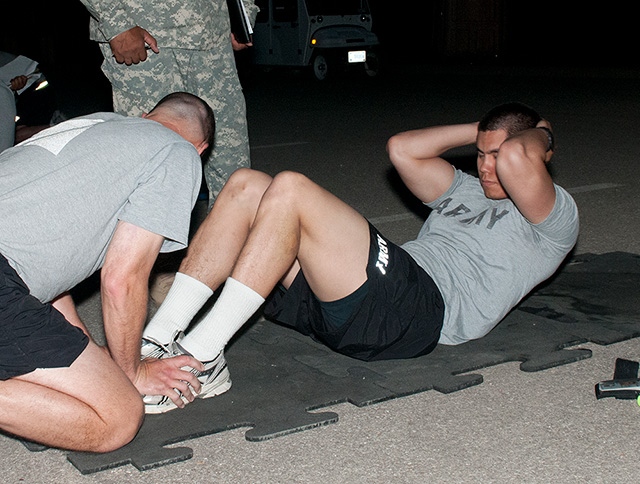The sit-up test is a measure the endurance of the abdominal and hip-flexor muscles. The aim of this test is to perform as many sit-ups as you can in two minutes. This abdominal muscle fitness test forms part of the Army Physical Fitness Test (APFT), performed by US Army personnel every six months.
test purpose: This test measures the endurance of the abdominal and hip-flexor muscles.
equipment required: floor mat or flat ground, stopwatch
pre-test: Explain the test procedures to the subject. Perform screening of health risks and obtain informed consent. Prepare forms and record basic information such as age, height, body weight, gender, test conditions. Perform an appropriate warm-up. See more details of pre-test procedures.
procedure: The aim of this test is to perform as many sit-ups as you can in two minutes. The starting position is lying on your back with your knees bent at a 90-degree angle. Feet may be up to 12 inches apart. Your fingers must be interlocked behind your head. A second person holds your ankles with the hands only. On the command ‘get set,’ the starting position is assumed, and on the command ‘go,’ start the sit-up by raising your upper body forward to or beyond the vertical position (meaning that the base of your neck is above the base of your spine), and then lower your body until the bottom of your shoulder blades and the backs of your hands touch the ground. Pausing to rest is permitted only in the up position.
 Army recruits doing the sit up assessment
Army recruits doing the sit up assessmentscoring: The maximum number of correctly performed sit ups is recorded. The scoring depends on the sex and age of the participant. See APFT for more information about scoring.
comments: The sit up will not be counted if you fail to reach the vertical position, fail to keep your fingers interlocked behind your head, arch or bow your back and raise your buttocks off the ground to raise your upper body, or let your knees exceed a 90-degree angle. The heel is the only part of your foot that must stay in contact with the ground. Your head, hands, arms, or elbows do not have to touch the ground.
The Test in Action
- This fitness test forms part of the US Army Physical Fitness Test (APFT)
Similar Tests
- General Abdominal Endurance Test description.
- The Marine PFT Sit up procedure & the Navy PRT sit-up test
- The Eurofit 30 seconds sit-up test
- Simple sit-up test that you can do at home
- The Presidents Challenge sit-up test
Related Pages
- About Abdominal Testing
- APFT testing discussion and scoring
- Videos of Sit Up Fitness Tests
- Other speed and power tests, all fitness test list
- Sit up exercise at the beach or at home
- Sit Up World Records


 Current Events
Current Events